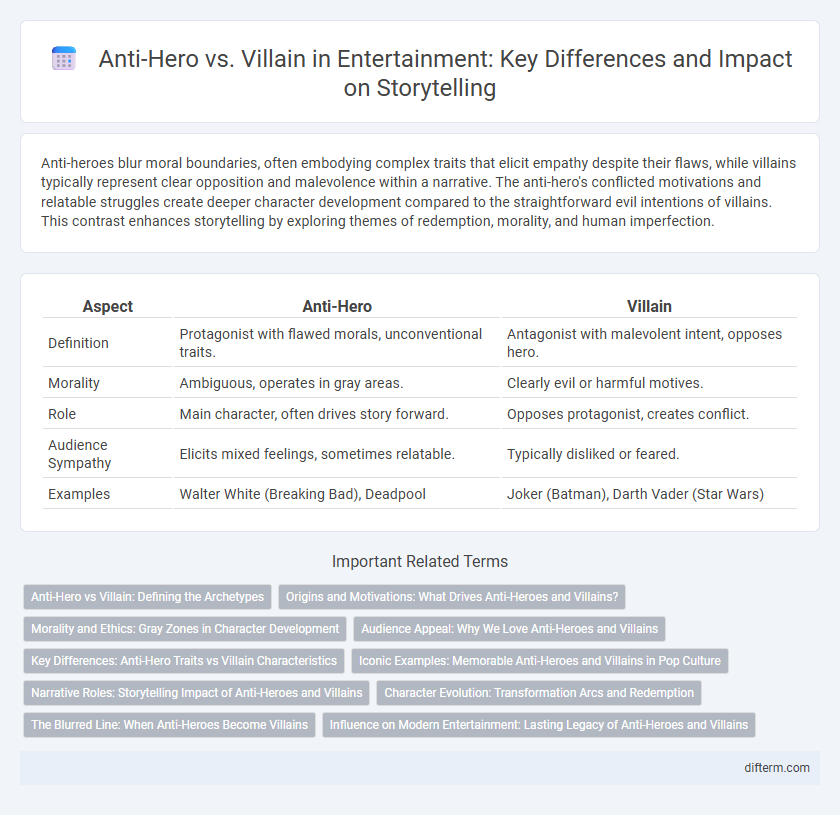Anti-heroes blur moral boundaries, often embodying complex traits that elicit empathy despite their flaws, while villains typically represent clear opposition and malevolence within a narrative. The anti-hero's conflicted motivations and relatable struggles create deeper character development compared to the straightforward evil intentions of villains. This contrast enhances storytelling by exploring themes of redemption, morality, and human imperfection.
Table of Comparison
| Aspect | Anti-Hero | Villain |
|---|---|---|
| Definition | Protagonist with flawed morals, unconventional traits. | Antagonist with malevolent intent, opposes hero. |
| Morality | Ambiguous, operates in gray areas. | Clearly evil or harmful motives. |
| Role | Main character, often drives story forward. | Opposes protagonist, creates conflict. |
| Audience Sympathy | Elicits mixed feelings, sometimes relatable. | Typically disliked or feared. |
| Examples | Walter White (Breaking Bad), Deadpool | Joker (Batman), Darth Vader (Star Wars) |
Anti-Hero vs Villain: Defining the Archetypes
Anti-heroes blur the lines between heroism and villainy by displaying flawed, morally ambiguous traits, often acting out of self-interest or questionable motives. Villains embody opposition to traditional heroism, characterized by clear malicious intent, ethical corruption, and a desire to impose harm or chaos. Understanding the nuances between anti-heroes and villains enhances narrative complexity and audience engagement in entertainment storytelling.
Origins and Motivations: What Drives Anti-Heroes and Villains?
Anti-heroes often emerge from complex, morally ambiguous backgrounds that blur the lines between good and evil, driven by personal code and redemption rather than pure malice. Villains typically originate from trauma, greed, or a pursuit of power, motivated by selfish desires or vengeance that challenge societal norms and heroes' ideals. These distinct origins and motivations drive their actions, shaping conflicts and character development within narratives.
Morality and Ethics: Gray Zones in Character Development
Anti-heroes blur the lines of morality by embodying traits that challenge traditional ethical standards, often displaying flawed but relatable human qualities. Villains, in contrast, typically represent clear moral opposition, driven by selfish or malicious intent without redeeming characteristics. Exploring these gray zones in character development deepens audience engagement by highlighting complex motivations and the nuanced spectrum between good and evil.
Audience Appeal: Why We Love Anti-Heroes and Villains
Anti-heroes and villains captivate audiences by blurring the lines between morality and motivation, offering complex characters that challenge traditional notions of good and evil. The appeal lies in their flawed humanity and unpredictable actions, which create tension and engagement, making stories more relatable and emotionally charged. Fans are drawn to the depth and nuance of anti-heroes and villains, finding fascination in their internal struggles and the moral ambiguity that adds richness to entertainment narratives.
Key Differences: Anti-Hero Traits vs Villain Characteristics
Anti-heroes often possess morally ambiguous traits and complex motivations, acting with flawed but relatable humanity, while villains embody clear malevolence and selfish intent that drive conflict. Anti-heroes typically operate with a personal code and can evoke audience sympathy despite questionable actions, contrasting with villains who are primarily antagonistic forces. The nuanced nature of anti-heroes allows for character development beyond evil archetypes, whereas villains usually represent unambiguous threats within a narrative.
Iconic Examples: Memorable Anti-Heroes and Villains in Pop Culture
Iconic anti-heroes like Tony Soprano from *The Sopranos* and Walter White from *Breaking Bad* captivate audiences by blurring moral lines, showcasing complexity and vulnerability. Memorable villains such as Joker from *The Dark Knight* and Darth Vader from *Star Wars* embody chaos and dark power, becoming symbols of fear and menace in pop culture. Both archetypes drive compelling narratives by challenging traditional notions of heroism and evil.
Narrative Roles: Storytelling Impact of Anti-Heroes and Villains
Anti-heroes challenge traditional morality by blending heroic qualities with flaws, creating complex and relatable characters that drive nuanced narratives. Villains embody opposition and conflict, often serving as catalysts for the protagonist's growth and shaping story tension. The interplay between anti-heroes and villains enhances storytelling depth, fostering audience engagement through moral ambiguity and compelling character arcs.
Character Evolution: Transformation Arcs and Redemption
Anti-heroes exhibit complex character evolution through transformation arcs that often include moral ambiguity and moments of redemption, contrasting sharply with villains whose development typically centers on deeper descent into immorality. Redemption themes in anti-heroes highlight internal conflict and gradual change, showcasing vulnerabilities that make their journeys compelling and relatable. Villains rarely experience such positive evolution, instead reinforcing their roles as antagonists by solidifying destructive motives through their arcs.
The Blurred Line: When Anti-Heroes Become Villains
The blurred line between anti-heroes and villains challenges traditional storytelling by creating complex characters who exhibit morally ambiguous behaviors, often committing acts typically associated with villains while maintaining audience sympathy. Anti-heroes such as Walter White from "Breaking Bad" and Tony Soprano from "The Sopranos" exemplify this phenomenon, as their flawed motivations and ethical compromises blur the definition of heroism. This convergence pushes narratives to explore themes of redemption, morality, and the duality of human nature, enriching the entertainment experience.
Influence on Modern Entertainment: Lasting Legacy of Anti-Heroes and Villains
Anti-heroes and villains have profoundly shaped modern entertainment by challenging traditional notions of morality and complexity in character development. Their nuanced portrayals drive audience engagement, encouraging deeper emotional investment and critical reflection on ethical ambiguity. The lasting legacy of these characters is evident in diverse media, from television dramas to video games, where flawed protagonists and morally gray antagonists dominate storytelling trends.
anti-hero vs villain Infographic

 difterm.com
difterm.com